[ad_1]
A soundbar is an attractive alternative to a full-blown outboard speaker system. It offers better sound quality than a TV’s built-in audio, and it’s much more convenient to set up and use. On the other hand, a soundbar can’t reproduce a fully directional surround or immersive soundfield like a system with separate speakers located around the listening area.
Or can it? That’s the goal Sennheiser set for itself with its Ambeo Soundbar. This high-end behemoth sits near the top of the soundbar price range and claims to reproduce a virtual 5.1.4 immersive soundfield—a claim that has some merit, though it never fooled me into thinking I was listening to an actual immersive multi-speaker system.
Updated April 23, 2021 to report Sennheiser has released a firmware update for the Ambeo Soundbar that adds support for Sony’s immersive 360 Reality Audio technology. We returned our review unit shortly after this review was published, so we won’t be able to evaluate the new feauture, but we wanted our readers to know about it.
Ambeo feature set
The Sennheiser Ambeo Soundbar is massive, measuring about 50x5x7 inches (WxHxD) and weighing almost 41 pounds. It sports a total of 13 speaker drivers—six 4-inch long-throw, cellulose-sandwich cone woofers, five 1-inch aluminum-dome tweeters (two of which fire to the sides at an angle), and two upfiring 3.5-inch full-range drivers powered by a total of 500 watts. The frequency response is said to extend from 30Hz to 20kHz (-3dB).
 Sennheiser
SennheiserA total of 13 drivers include nine that fire forward, two that fire to the sides at an angle, and two that fire upward (not seen here because their grilles have not been removed in this photo).
So, how does a single soundbar—even such a large one—simulate the effect of a 5.1.4 speaker system? In this case, it uses all those drivers and some serious DSP to direct the surround and overhead channels to the room’s walls and ceiling, where they are reflected toward the listening area. According to Sennheiser, the effect is best if the walls and ceiling are no more than five meters (about 16 feet) from the soundbar; otherwise, the reflected sound might be noticeably delayed.
To accomplish this feat of virtualization, the Ambeo Soundbar must be calibrated to the room in which it will be used. In addition to the soundbar itself, the package includes a 28-inch-tall, free-standing calibration microphone attached to its own heavy base and a long cable that connects to the front of the soundbar. To calibrate the unit, you place the mic so its top is at ear height in the listening position and hold the Ambeo button on the remote or the top of the unit. The soundbar plays a series of sweeping tones and then calibrates the DSP based on what the microphone picks up from reflections in the room.
Physical inputs on the back include three HDMI 2.0a ports (18Gbps), one ethernet port, one Toslink optical port, and one pair of RCA analog-audio jacks as well as a 2.5mm microphone input on the front for the calibration mic. It also provides several wireless inputs, including Bluetooth 4.2 and dual-band Wi-Fi (802.11a/b/g/n/ac). Finally, it has Google Chromecast built in, and it can join a UPnP media network. Outputs include one HDMI 2.1 port with eARC and a subwoofer pre-out with an RCA connector. A USB port supports service and firmware updates but not media playback from storage devices.
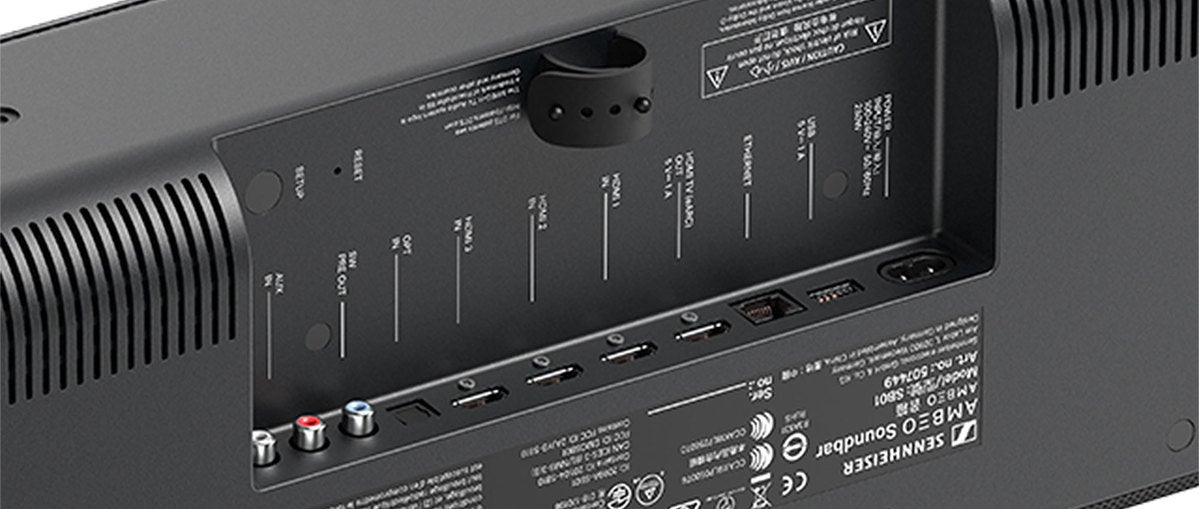 Sennheiser
SennheiserThe soundbar’s rear-panel connections include (L-R): stereo analog-audio input, subwoofer line output, Toslink digital-audio input, three HDMI 2.0a inputs, one HDMI 2.1 output with eARC, ethernet port, USB port for service and firmware updates, and AC power receptacle. An integrated cable tie keeps the cables tidy.
The Ambeo Soundbar can decode a wide range of audio codecs, including virtually all varieties of Dolby (including Dolby Atmos) and DTS (including DTS:X and DTS 96/24). Other supported codecs include DSD (the format used with SACD discs) and MPEG-H, a relatively new codec intended for use with next-generation TV broadcasting via ATSC 3.0. It can also upmix stereo and 5.1 content into a fully immersive soundfield.
You can engage the Ambeo virtualization with three intensity levels (Light, Standard, Boost), and you can cut or boost four bands of EQ by up to ±10dB. Of course, you can disable it altogether as well. The soundbar also offers five preset sound modes: Movie, Music, News, Sports, and Neutral. In addition, it offers a Night mode that compresses the dynamic range so you can hear everything without having to crank it up and possibly disturb others trying to sleep in the next room.
If the audio is in one of the Dolby formats, the Ambeo Soundbar can utilize Dolby Virtualizer, in which case the Ambeo 3D audio effect is disabled. It also offers Dolby Dynamic Range Control (DRC) with three different settings (Auto, Normal, Heavy) and dialog normalization. If the audio is a DTS bitstream, you can set DRC to any value from 0 to 100 percent and boost dialog up to 6dB. These and most other controls are found in the Sennheiser Smart Control app (more in a moment).
Of course, you can place the soundbar on a credenza or other surface, and it comes with protective feet you can install if you wish. You can also wall-mount it with an optional hardware kit. Keep in mind, however, that it’s five inches tall, so the bottom of the TV needs to be at least that far above the surface where the soundbar sits.
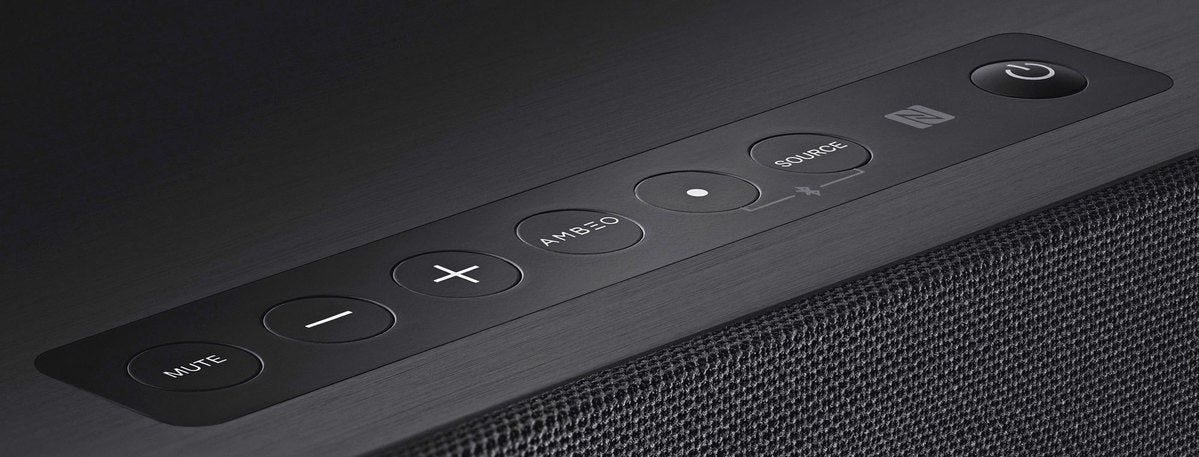 Sennheiser
SennheiserThe controls on top of the soundbar include (L-R): mute, volume up, volume down, Ambeo on/off, multifunction, source selection, and power on/off. The NFC antenna is located between the source and power buttons. If you don’t have an NFC-capable device, you initiate Bluetooth pairing by holding the multifunction and Source buttons.
Ambeo user interface
The front of the soundbar sports an OLED display with an ambient-light sensor and status LED in the center. An LED-illuminated Ambeo badge on the right-hand side of the cabinet lights up when the virtualization is engaged. Fortunately, you can control the brightness of the display and Ambeo indicator using the Smart Control app.
On the top of the soundbar are a few basic control buttons, including power on/off, source selection, Ambeo on/off, volume up/down, and mute. A multifunction button lets you control playback of music files—press once to play or pause, press twice to skip to the next track, press three times to skip to the previous track. Pressing the multifunction and source buttons together for two seconds puts the soundbar in Bluetooth-pairing mode. If the device supports NFC pairing, you can simply hold the device close to the NFC logo on the soundbar and they will pair automatically.
The slender remote is blessedly simple, with only 14 well-separated buttons. Naturally, there are buttons for power on/off button, Ambeo on/off, and mute on/off as well as the same multifunction button as found on the unit itself. The source up/down and volume up/down buttons are slightly contoured (up is convex, down is concave), making them very easy to find by feel. The five sound modes and night mode have their own dedicated buttons, which is great, though they all feel the same, and without illumination, you have to memorize where they are to change modes in the dark.
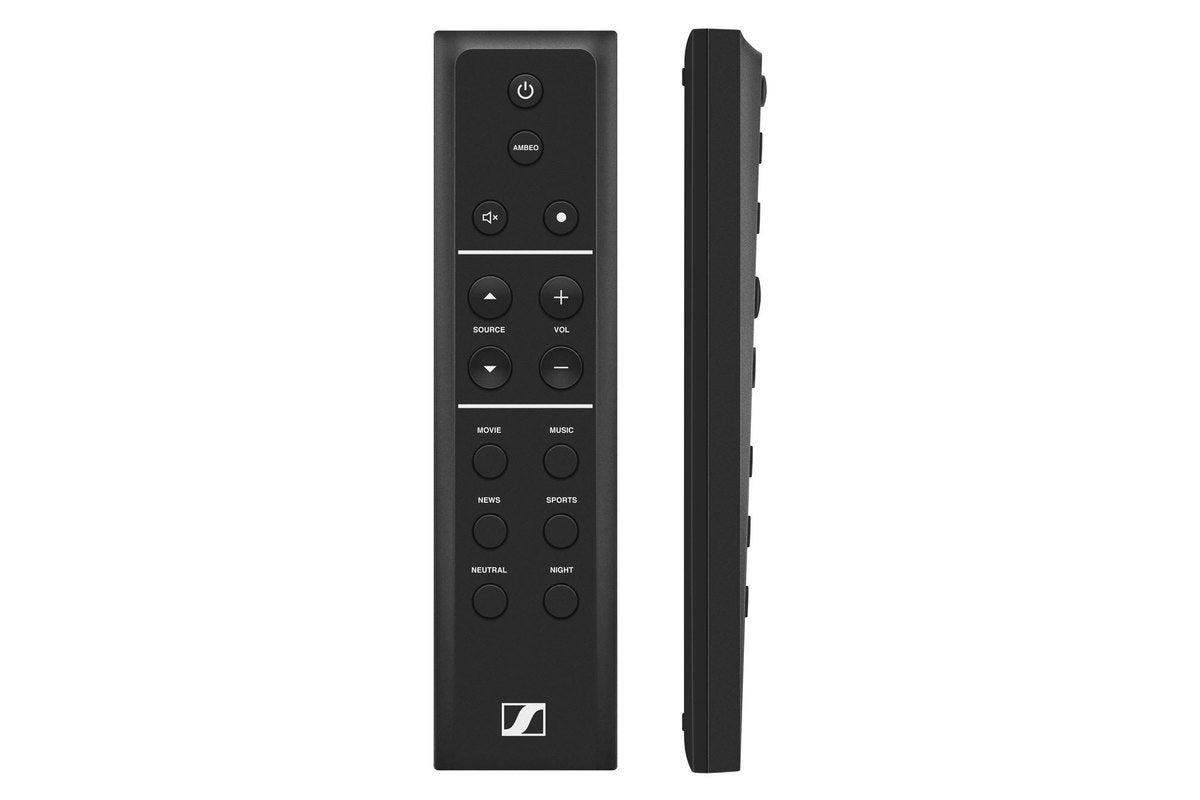 Sennheiser
SennheiserThe remote is small and simple, with well-separated buttons that are easy to find by feel. I wish the mode buttons at the bottom were illuminated; it’s difficult to remember which is which in the dark.
As you might expect, Sennheiser’s Smart Control app offers the most control options. Of course, you can power the soundbar on and off, control the volume, select inputs and sound modes, and engage and disengage the Ambeo effect and Night mode. In addition, the app lets you select the strength of the Ambeo effect and adjust the 4-band EQ as well as rename the inputs. You can also control the brightness of the display and Ambeo LED manually or set it to automatically adjust according to the amount of ambient light in the room. As mentioned earlier, the Dolby and DTS DRC and dialog controls are available in the app as well. Even better, you can specify that your settings are remembered for each input as well as whether or not the soundbar plays audible cues for various actions.
Overall, the app is designed quite well. The basic controls are found on the home screen, while the Ambeo strength and EQ controls are two levels into the Acoustical Settings; they can be adjusted and saved separately for each sound mode, which is very nice. All other controls are found in the Device Settings, which are organized fairly intuitively.
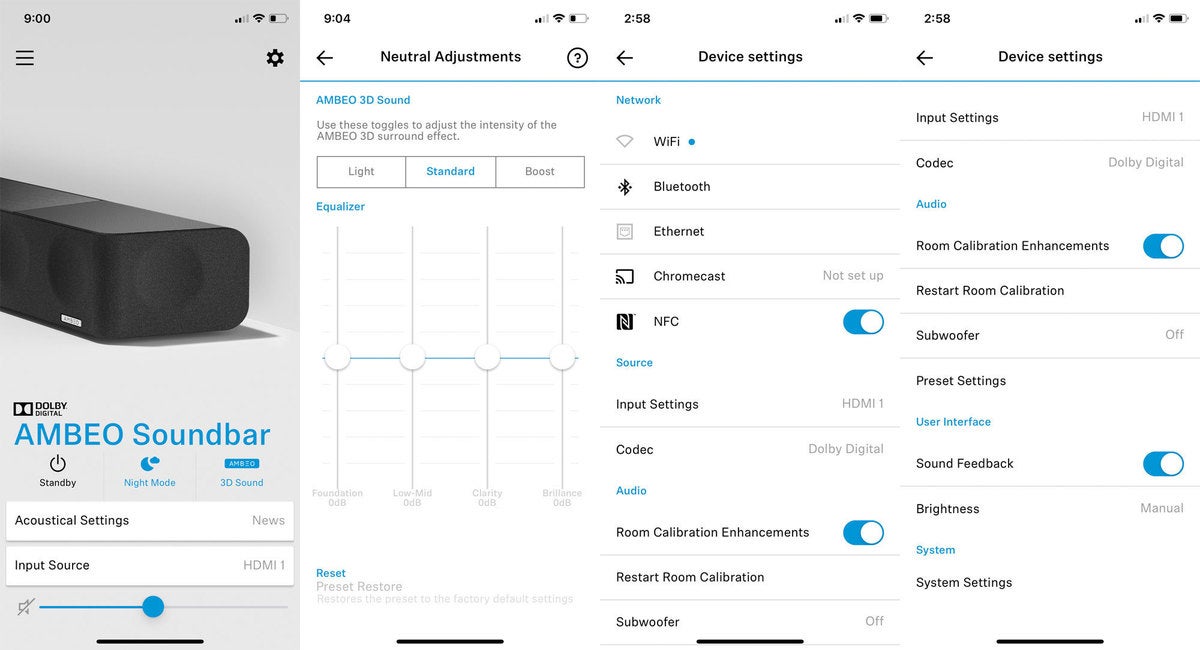 Scott Wilkinson / IDG
Scott Wilkinson / IDGSennheiser’s Smart Control app offers lots of control over the Ambeo Soundbar, including basic settings on the home screen (left), different levels of virtualization and a 4-band EQ, and more device settings than can fit in a single screen.
Ambeo performance
I placed the Ambeo Soundbar on a small table in front of my Sony 65A1E OLED TV; fortunately, the table is just low enough so the soundbar didn’t block any of the screen when I was seated in my normal chair. The room is almost entirely rectangular with standard drywall, though there is an open closet to the right of the seating area, and one of the equipment racks is against the wall next to the closet. There are some shelves of Blu-rays to the left of the seating area.
Next, I set up the calibration microphone at ear height in my chair, connected it to the soundbar, and ran the calibration routine. It plays a set of sweeping test tones, after which the DSP processes those measurements. As I listened to the sweeps, I was particularly impressed with the low-frequency output.
Unfortunately, the calibration failed, even after repeated attempts. A Sennheiser rep suggested that I cycle the AC power by unplugging the unit for 15 minutes, then plugging it back in and trying again. Sadly, that didn’t work, so they sent me another calibration microphone, which worked the first time.
I connected three source devices to the HDMI inputs—a Dish Hopper 3 satellite receiver, a Roku Ultra 4K streamer, and an Oppo UDP-203 UHD Blu-ray player—using 18Gbps cables. I also connected the soundbar’s HDMI output to the calibrated HDMI input on the TV.
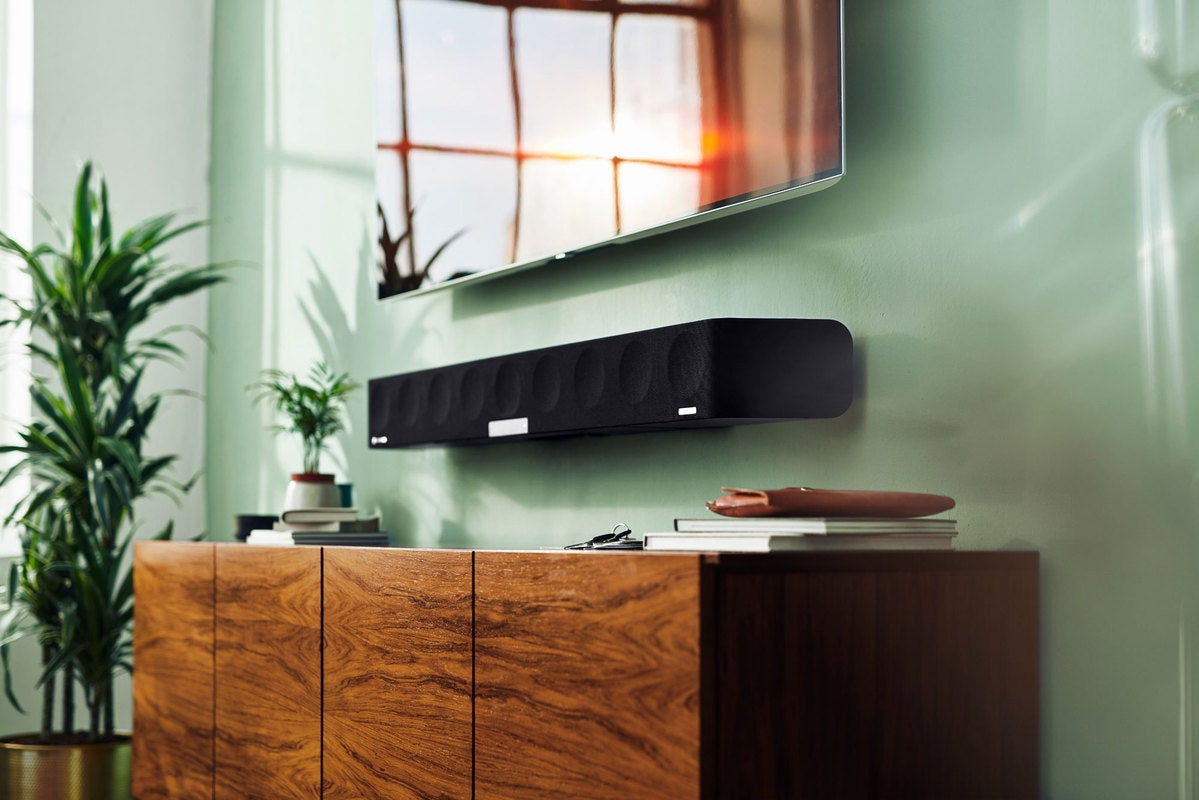 Sennheiser
SennheiserThe Sennheiser Ambeo can be wall mounted beneath your TV using an optional kit.
Each time I turned on the soundbar, it switched to the HDMI TV (eARC) input. Unfortunately, I can find no control in the app that lets you specify which input it should select at power up. According to Sennheiser, the soundbar should automatically select the most recent active input, but even when I powered up one of the source devices last, the soundbar’s input remained on HDMI TV, so I had to manually switch to the desired input every time. I wish the app included a setting that lets you specify something like “stay on the input selected at last power down” or “always select HDMI X when powering up.”
Another operational problem was that the app lost its connection to the soundbar after my phone went to sleep. When I woke it up and went to the app, it was no longer connected, and I had to manually reconnect, which got tiresome after a while.
I started my formal evaluation by playing the 5.1.4 test tones—pink noise, actually—from the Dolby Atmos demo Blu-ray. Of course, the front LCR channels came from where they were supposed to, but the surround and overhead channels were also in front of me. The surround channels were farther to the sides than the front LR channels, but they didn’t appear to come from the sides of the room. The overhead channels appeared to be coming from the upfiring speakers in the soundbar, not from the ceiling.
The helicopter and 747 takeoff demos from the Dolby Atmos disc sounded about the same—entirely in front of me with some width and height in the soundstage. The rainstorm demo, however, was much more effective; the sound of the rain actually appeared to be coming from overhead, especially the higher frequencies.
I compared the Ambeo effect with Dolby Virtualization during the rainstorm demo, and found that Ambeo was much more effective. Dolby Virtualization rendered the sound more in the front of the room with a somewhat smaller soundstage.
Next, I played some of the short Atmos demos with video. In all cases, overhead sounds with high frequencies appeared to come from overhead, and the width of the soundstage was very good, though I heard nothing from where actual surround speakers would be. The Horizon demo includes a plane flying over from back to front, but the entire sound came from the front. On the plus side, low frequencies were particularly impressive.
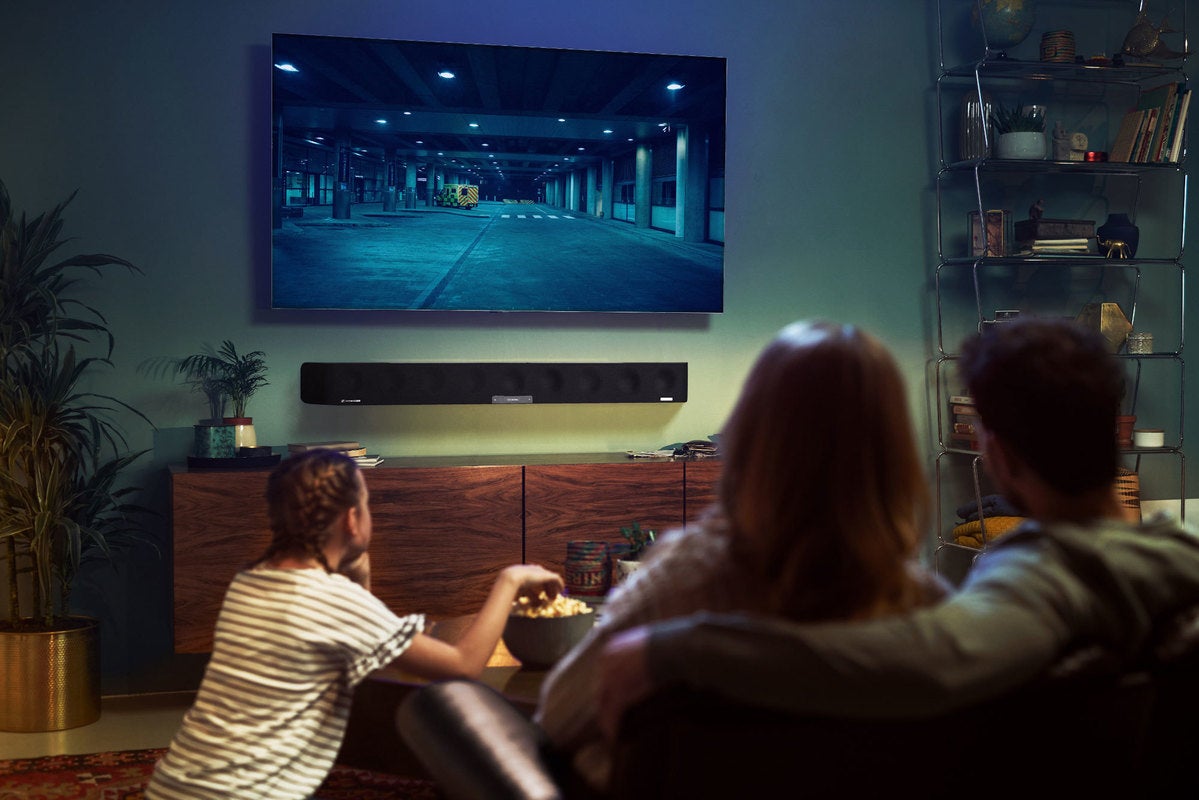 Sennheiser
SennheiserThe height of your ceiling, the shape of your room, and the furniture inside the room will all have an impact on the Ambeo’s performance.
[ad_2]
Source link